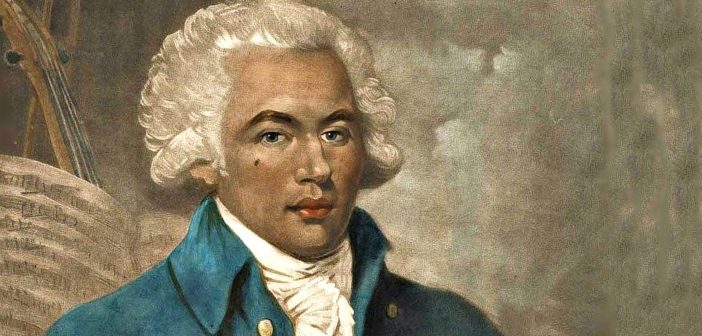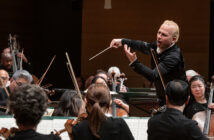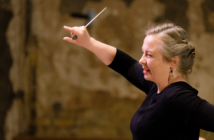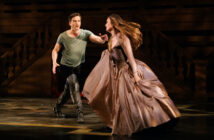
This page is also available in / Cette page est également disponible en:
![]() Francais (French)
Francais (French)
The history of music, like history as a whole, is often cruel. It raises a limited number of individuals to the rank of immortals while others, famous in their day, are forgotten. We sometimes see unexpected reversals. Even before his death in 1750, Johann Sebastian Bach saw his fame eclipsed by that of his sons Carl Phillip Emanuel and Johann Christian. History, as it turns out, does not hold in high esteem the Bachs that the men and women of the 18th century would have thought of first.
In that era, the risk of being forgotten by subsequent generations was all the greater for a woman or man of colour. However, one such person, despite the challenges and discrimination, was able to make a name for himself among the musicians of his time and even beyond the realm of music.
Taking up arms
Born in the French West Indies, Joseph Boulogne [or Bologna]de Saint-George was the illegitimate son of a plantation owner and an enslaved mother of African descent. His father, who recognized him fully and passed on his surname, wished to give him an education comparable to that of the children of the nobility. They arrived in France together in August 1753, when Joseph was 7. After a few years in boarding school, the latter joined the fencing school of Nicolas Texier de la Boëssière. Trained in literature, science and horseback riding, the young man of mixed race proved to be particularly adept at foil. Challenged to a duel by Alexandre Picard, a master fencer who had called him an “upstart mulatto from Böessière,” Saint-George won a symbolic victory against the backdrop of a debate for or against slavery. In his Biographie universelle des musiciens, the musical lexicographer François-Joseph Fétis sums up his talents as follows: “Endowed with prodigious strength and agility, he had in this art a superiority that became legendary, and shone also in all other activities. No one could match him as a runner; in dance he was the model of perfection; an excellent squire, he rode the most difficult horses bareback and made them docile; he skated with perfect grace and stood out among the best swimmers of his time.”
And the music?
The life of the man who would become the “Chevalier de Saint-George” is shrouded in mystery. It is difficult to assign precise dates or pinpoint details, particularly in the early years, including those related to his musical training. What we know for sure is that in 1764, aged 19, he was the dedicatee of two violin concertos by composer Antonio Lolli, proof of his ability to play the instrument. In 1766, François-Joseph Gossec also thought of him when he published the Six Trio Sonatas Op. 9. This eminent 18th-century composer was one of the main patrons of Saint-George. In 1769, he welcomed him to the violin section of his orchestra.
Three years later, Saint-George created a sensation with his debut as the soloist in two violin concertos he composed himself. The following year, he took over as conductor, replacing Gossec. This is how his career began as both concert performer and music director, a career he tried to reconcile with his revolutionary sentiments as captain of the Garde nationale in Lille in northern France, then as colonel of the “légion des Américains et du midi” (first regiment in Europe to be made up of persons of colour). His intention to become director of the l’Académie royale de musique would be thwarted by a petition from three women, leading performers at the Opéra, asserting that “their honour and the delicacy of their conscience would never allow them to be subjected to the orders from a mulatto.” Despite this rebuff, Saint-George will continue to be favored by King Louis XVI and Marie-Antoinette.
The “Mozart noir”
During this time, Saint-George continued to pursue composition. Inspired by the style of Haydn, he began writing his first string quartets. After these came sonatas for violin and fortepiano, violin concertos and concertante symphonies in which the violin is predominant.
Furthermore, Saint-George applied himself to opera. He composed six, only one of which has come down to us in its entirety: L’amant anonyme (1780), a comedy mixed with ariettas and ballets in two acts based on a play by Félicité de Genlis. Last November this work was published in a critical edition by Opera Ritrovata and presented by the Los Angeles Opera.
Excerpts from L’amant anonyme had already been heard on record, notably by Toronto’s Tafelmusik baroque orchestra in 2003, alongside the Violin Concerto in D Major Op. 3, and the Symphony in G Major. The style of Saint-George, elegant without being pompous, is certainly imbued with Viennese classicism, but it would be wrong to equate it solely with Mozart. More salient is the influence of Gossec, his composition teacher.
Saint-George was greatly appreciated by the public at the time, not only for his exceptional physique, sporting exploits and fencing talent, but also for his music. Later generations would remember him more for his bodily prowess and less for his music. Fortunately, the recent rediscovery of L’amant anonyme sheds new light on this enigmatic and fascinating character.
This page is also available in / Cette page est également disponible en:
![]() Francais (French)
Francais (French)















